What is Chi energy?
Is Chi (or qi) a real phonemonon?
Can you experience the feeling of Chi in your body?
Can Chi energy be developed?
What are the lower Dan Tien and the three treasures?
In this in-depth guide, we’ll explore these questions and much more.
Let’s dive in …
What is Chi Energy?
Chi energy, or qi, represents the life force energy or bioelectrical energy inherent in the human body.
Chi translates as air or breath, but it’s also used to represent energy, vital essence, and life force. At its fundamental basis, Chi is information transmitted through the human body and the environment.
Master Lam Kam Chuen explains in The Way of Energy,1Lam Kam Chuen, The Way of Energy, 12.
The energy in our bodies is so natural and so spontaneous, we almost never stop to think about it. It is like the constant rhythm of our lungs and the ceaseless circulation of our blood.
As Mantak Chia explains:2Mantak Chia, Awaken Healing Energy Through the Tao, 24.
The Chi is the primordial life force itself. It begins in human life with the piercing of an egg by a sperm cell. From this original fusion an enormously complex new human being develops. ‘Chi’ is the continuous flow of energy linking the various tissues, organs and brain functions into a unified whole—a person.
The Chinese have long believed Chi is the fundamental energy that sustains all life.
The Evidence of Chi Energy
If you’re unfamiliar with the concept or experience of Chi energy, it’s natural to question its existence.
When I first started practicing various forms of Qigong and internal martial arts over 15 years ago, I too was skeptical. However, as I began to have direct experiences with Chi, my skepticism waned.
As your body begins to open and the energetic pathways become unblocked, you begin feeling sensations of internal movement. This movement is an increase in blood flow combined with Chi. (The direct experience of Chi comes later as it begins to consolidate.)
Modern science’s understanding of Chi is limited because it lacks the tools for measuring it.
The Human Biofield and Chi Transmission
But that’s changing. The study of the human biofield in energy medicine is leading to creative methods of measuring subtle energy fields.3https://www.faim.org/measurement-of-the-human-biofield-and-other-energetic-instruments However, subtle energy fields are not necessarily the same thing as Chi.
Perhaps the most compelling evidence comes from numerous documented cases of Chi transmission from qigong masters like Dr. Yan Xin to heal their patients.4Yan Xin, Secrets and Benefits of Internal Qigong Cultivation, 1994.
There have also been many demonstrations by Chi-cultivation practitioners that defy modern science. (See this brief documentary on a Chi healer’s extraordinary abilities.)
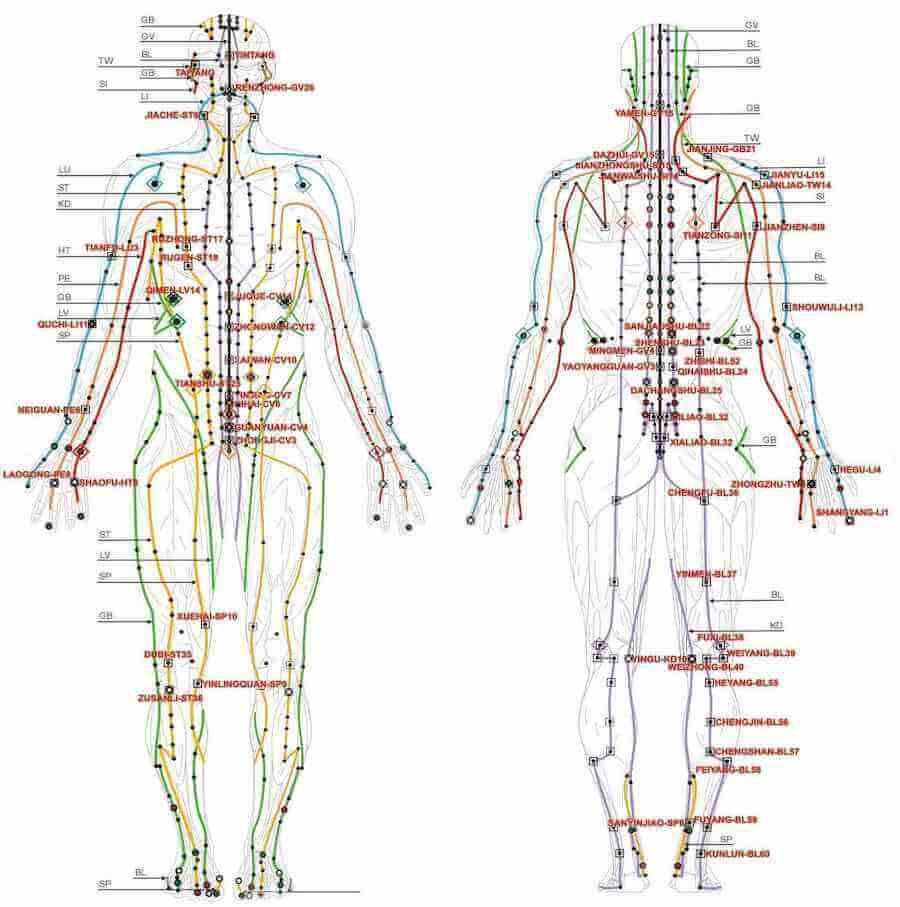
Human Energy Meridians (with Acupuncture Points)
The Energy Meridians of the Human Body
Chi energy circulates through the body via minute pathways called meridians.
As Dr. Stephen T. Chang explains in The Book of Internal Exercises:5Stephen T. Chang, The Book of Internal Exercises, 1980, 7.
The meridians are symmetrical and bilateral channels with a diameter ranging between 20 and 50 millicrons. They exist beneath the surface of the skin and have a thin membranous wall which is filled with transparent, colorless fluid.
The main meridians develop intricate subsidiary branches. The places where these branches reach the skin are classically used as target points for acupuncture.
Again from Lam Kam Chuen,6Ibid, 19.
Throughout the body your energy circulates along channels which in the West are called ‘meridians.’ These often run in parallel with your cardiovascular system. Through an ever finer network of radiating routes, the Chi animates the entire living matter of your body.
Many centuries ago, Taoist adepts mapped out these vast meridian channels through deep meditation.
5 Benefits of Cultivating Chi Energy
What benefits can we derive from cultivating one’s Chi?
Some of the benefits of cultivating Chi include:
- Increased longevity
- Stronger body
- Clearer mind
- Greater resilience and willpower
- Self-healing capabilities
Let’s quickly look at each of these benefits.
Longevity
Our lifespan is closely tied to our Jing and Chi energy. Living in alignment with our Chi—that is, living more naturally—supports a long, healthy life.
Stronger Body
When our Chi is blocked, it means that the energy in the body is stagnant. Stagnant energy leads to physical illness and disease. Learning to cultivate one’s Chi and develop what’s called the “Qigong Body” helps strengthen your physical body so it can support you into old age.
Clearer Mind
Muddled thinking, brain fog, and a lack of clarity are also a result of blocked Chi. When one’s Chi is flowing freely, the mind is lucid, active, and alert.
Greater Resilience & Willpower
Chi blockage leads not only to physical ailments but to emotional and mental problems as well. The absence of Chi weakens our Will while cultivating one’s Chi strengthens our emotional resilience and increases our innate willpower.
Self-Healing
If this topic of Chi is new to you, it’s difficult to appreciate the intimate relationship between Chi, health, and disease. In cultivating your Chi, you necessarily develop greater sensitivity and body awareness. You begin to detect potential problems in advance.
More importantly, when your energetic channels begin to open, many of the problematic symptoms you may be experiencing start to resolve themselves. The body is designed to heal itself, but when the Chi can’t flow freely, this innate self-healing mechanism is blocked.
The Three Treasures of Taoism
In Taoist philosophy, we have the three treasures: Jing, Chi, and Shen.
Jing, Qi, and Shen are energetic substances or frequencies that control many aspects of our health, behavior, psyche, and spiritual development.
But even though these three treasures are considered three different substances, they are of the same essence, similar to how water can take the form of gas, liquid, and solid (ice).
Let’s take a closer look at each of the three treasures:
1 – Jing (Essence)
Jing is the lowest vibration of the three treasures.
Many people mistakenly think Jing is synonymous with sexual energy or seminal fluid. While Jing does include this sexual energy, it’s not technically the same thing. (However, excessive sex does deplete one’s Jing.)
Jing most closely translates in English to Life’s Essence.
2 – Chi (Energy)
The Essence (Jing) of the body converts to Chi (or Qi), which most closely translates to energy.
Chi is a higher vibration than Jing, and it transports information throughout the body’s energy system.
The food we eat also converts to Chi energy.
3 – Shen (Spirit)
Shen, the highest or most refined vibration, is the energy of consciousness itself. Many schools of Taoism consider Shen the individual’s Spirit.
In Western integrative psychologies, Shen is akin to the Higher Self or higher consciousness. Shen manifests as bright white light, and its frequency is closest to “Heaven.”
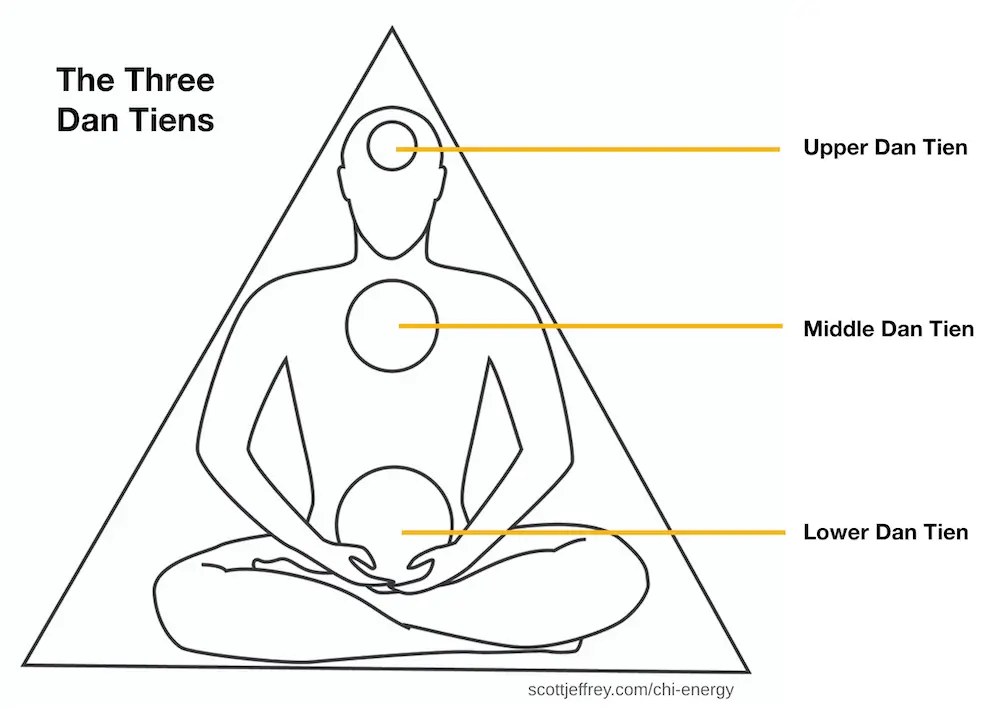
The Three Dan Tiens
The Three Dan Tiens
In addition to the meridian system and the three treasures, in the Taoist internal arts, there are the three Dan Tiens.
These Dan Tiens are primary energy centers within the human body, connected by the central branch called the thrusting meridian.
The three substances—Jing, Chi, and Shen—can be transported and converted through internal energy work called Nei Gong and Nei Dan practices.
From Damo Mitchell’s Daoist Nei Gong:7Damo Mitchell, Daoist Nei Gong, 2011, 65.
Each Dan Tien is a sphere of Qi which is held together within a type of energetic/magnetic field formed from the surrounding meridians. The center point of each Dan Tien is empty and able to fill with Jing, Qi or Shen so that it may be transformed into its next state.
The Lower Dan Tien
The lower Dan Tien is located behind and below the navel and at the midway point within the lower torso. (See instructions below.)
The lower dantien is considered the primary cauldron where the Chi energy is cultivated and distributed throughout the body.
The Middle Dan Tien
The middle Dan Tien is located in the heart region. It connects our energetic body with consciousness.
This energetic sphere relates to our transient emotions.
The Upper Dan Tien
The upper Dan Tien is within the head behind the Yintang point—the third eye region.
Shen is directed to the upper Dan Tien when it moves into the head and then into the “consciousness body.”
The Energetic Mechanics of the Lower Dan Tien
The bioelectric field of the lower Dan Tien is present at birth, however, by puberty, this field is dispersed. As a consequence, adults looking to cultivate their Chi need to rebuild this field.
The lower Dan Tien is akin to a gas tank in a vehicle. If your gas tank isn’t self-contained or if it is filled with holes, it can’t hold fuel. The same goes for the lower Dan Tien.
There are both Yin and Yang components to everything in the Taoist arts. The Yin, in this case, represents the form, or the organizing field of the lower Dan Tien. The Yang represents the energy, substance, or Chi that fills this organizing field.
To cultivate one’s Chi, one first must learn how to locate the lower Dan Tien region with their breathing and awareness (Yi). Then, one can begin rebuilding this bioenergetic field. Once this Yin field is rebuilt, Chi can be gathered and cultivated.
How to Locate the Lower Dan Tien
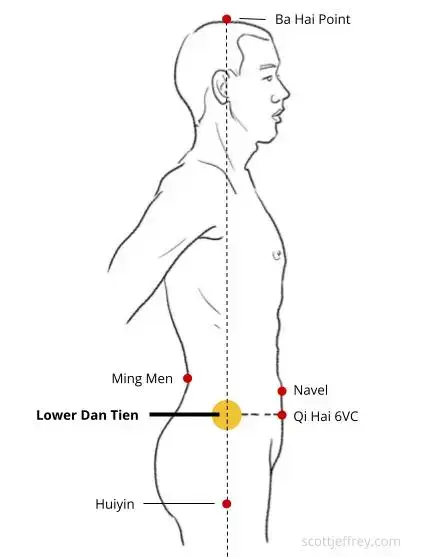
The Location of the Lower Dan Tien
Anyone interested in cultivating their chi will need to learn how to locate the lower Dan Tien with their minds.
First, place two fingers directly below the navel. Locate the Qi Hai point (REN 6) approximately two-finger thickness below the navel. (If you gently massage this point, it will feel slightly bruised.)
Qi Hai means “sea of qi.” This point is also called the false Dan Tien as many practitioners mistakenly think the lower Dan Tien is located here.
Next, constrict your perineum located between your genitals and the anus. This point is called Huiyin.
Imagine a vertical line going from the perineum up toward the crown of your head (Ba Hai) as illustrated above.
Another horizontal line goes from the Qi Hai toward your back.
In the crosshairs where these two lines intersect is the approximate location of the lower Dan Tien.
When you’re able to sink your awareness into this region and comfortably sustain it, a feeling of heat or a slight pulling sensation will signal that you’re in the correct location.
4 Things Block Chi Energy
As Lam Kam Chuen explains,8The Way of Energy, 12.
Our bodies are filled with energy, but it is blocked within us. We are born bursting with life, yet we grow old depleted of vitality.
So what blocks the natural flow of Chi energy within our bodies? Factors include:
- Negative emotions
- Physical tension
- Improper living
- Lack of integrity
Let’s look at each factor.
Negative Emotions
The primary culprit is negative emotions, especially fear. Stress, anxiety, and neurotic fear cause the muscles, sinew, and tendons to constrict, which stops the flow of Chi.
If this tension is temporary, it won’t matter because the flow of Chi energy will spontaneously resume.
However, due to unconscious patterning and the suppression and repression of emotions, this internal tension persists, leading to long-term energetic blockages.
Physical Tension
As you can see from the above, negative emotions like fear establish physical tension within the body. This chronic tension leads to improper physical movement, sitting, standing, and breathing.
Notice how a newborn and a very young child have incredible flexibility. Most little kids look like they are triple-jointed. But as we grow up, most of us become rigid and immobile due to physical tension. This rigidity reinforces Chi blockage throughout our bodies.
Improper Living
In addition to Chi being blocked by unprocessed negative emotions (trauma) and suppressed emotions, most people’s lifestyles lead to Chi blockage as well.
Our bodies are designed to move so that we feel calm, light, and free. We are NOT meant to sit in front of computers or devices, stare at television screens, or sit at desks all day. Simply put, our modern lives are an attack on the natural flow of Chi within us.
Additionally, dominant cultural values like competition, image, accumulation, material possessions, and a constant striving for higher self-esteem also block our natural life force energy. (More on this topic below.)
Lack of Integrity
Finally, dishonesty is another aspect of improper living that influences our Chi. Lying, for example, collapses various acupuncture meridians.
But an even greater problem is self-deception—that is, being dishonest with oneself. Self-deception is a sign that we’re divorced from our Self, or as they would say in depth psychology, one’s psyche is split.
These types of psyche splits, reinforced by dishonesty, disrupt the natural flow of Chi.
How to Unblock Chi Energy
When your Chi energy is unblocked, your experience of the body is very different. Most individuals have little awareness of the inner workings of their bodies. Most of us are completely numb in many regions of our bodies.
For example, when there’s no blockage, you can feel virtually every region of your body, including the movement of all of your organs. This level of sensitivity is what helps you detect and feel the flow of Chi (which is different from blood flow).
Some of the practices one can explore to help unblock their Chi include:
- Tuning the Breath
- Practicing Qigong
- Trauma-Release Exercises
- Acupuncture
Let’s examine each one.
Tuning the Breath
As we saw above, Chi energy blockage is largely a result of unprocessed emotions. When we experience negative emotions like fear for a prolonged time, it changes how we breathe.
As a consequence, to support the free flow of energy within the body, we must train ourselves to breathe properly so the body can become properly oxygenated and relaxed. In the Eastern traditions, this is often called “tuning the breath.”
Tuning the breath is less about exerting effort to breathe a certain way. It’s more about learning the principles of natural breathing and then allowing the body to return to this state.
See this in-depth guide on how to breathe properly.
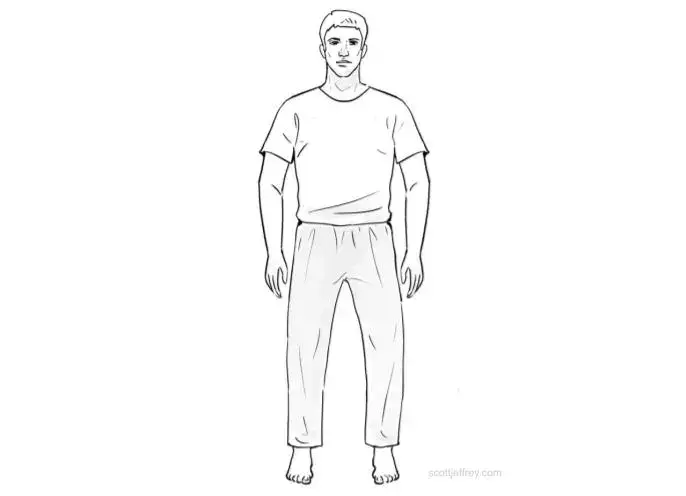
Wuji Standing Posture in Zhan Zhuang
Practicing Qigong
Qigong translates to the way of energy or energy skill. There are said to be thousands of qigong systems in the East. Qigong systems are comprised of specific stretching, movements, standing postures, forms, and breathing processes.
Many people are familiar with Tai Chi. Tai Chi is considered an internal martial arts form that’s largely built on the principles of qigong. (Many Tai Chi practitioners also train in qigong.)
One qigong practice that I highly recommend is called Zhan Zhuang, which translates to pole-standing or standing like a tree.
Zhan Zhuang helps you stabilize your energy and learn how to sink your awareness into your body.
See this in-depth guide on Zhan Zhuang.
Trauma-Release Exercises
For many individuals, qigong will not be sufficient for opening one’s body. In my experience, most qigong practices in the West are too gentle. (Gentle or soft qigong is more appropriate for elderly individuals.)
Western approaches to breaking up trauma within the body can be beneficial to many individuals interested in unblocking their Chi.
Dr. David Berceli’s Trauma Release Exercises (TRE) can be highly useful. They are designed to induce spontaneous shaking in the body that helps release trauma stored in the psoas muscle region. (Zhan Zhuang can produce a similar result if you stand for long enough.)
Here’s an introduction to TRE by Berceli.
Another option is Bioenergetic Analysis pioneered by Dr. Alexander Lowen. This system is also designed to help you release chronic muscular tension via deep stretches, movements, and breathing. (Just search for “bioenergetic analysis.” There’s a lot of information available online.)
Deep Stretching
At the core of methods like TRE and Bioenergetic Analysis are deep stretching systems that target specific body regions where most people have energetic blockage.
Learning how to stretch intentionally and carefully while breathing deeply with your awareness in a particular region is an important skill for unlocking stored tension and trauma.
For example, many individuals unconsciously hold tremendous jaw tension, blocking chi energy flow.
Deep stretching and conscious relaxation help you develop greater kinesthetic intelligence or body awareness.
Yoga-style stretches can be useful here too. The key is to learn how to sink your awareness into your body.
All of the above methods offer various stretching routines. Eventually, you can develop your own.
Acupuncture
Another classical approach to releasing energetic blockage in the Eastern arts is acupuncture. This ancient system uses an understanding of the body’s energy meridians to address physical symptoms related to blockages in specific branches.
Early on in my journey, I went to five or six different acupuncturists, including one who’s considered a multi-generational master. The results I experienced were marginal at best, but the results will vary.
You can also learn to do “self-acupuncture” without needles using nothing but your awareness (called Yi). See, for example, Damo Mitchell’s Heavenly Streams (2013).
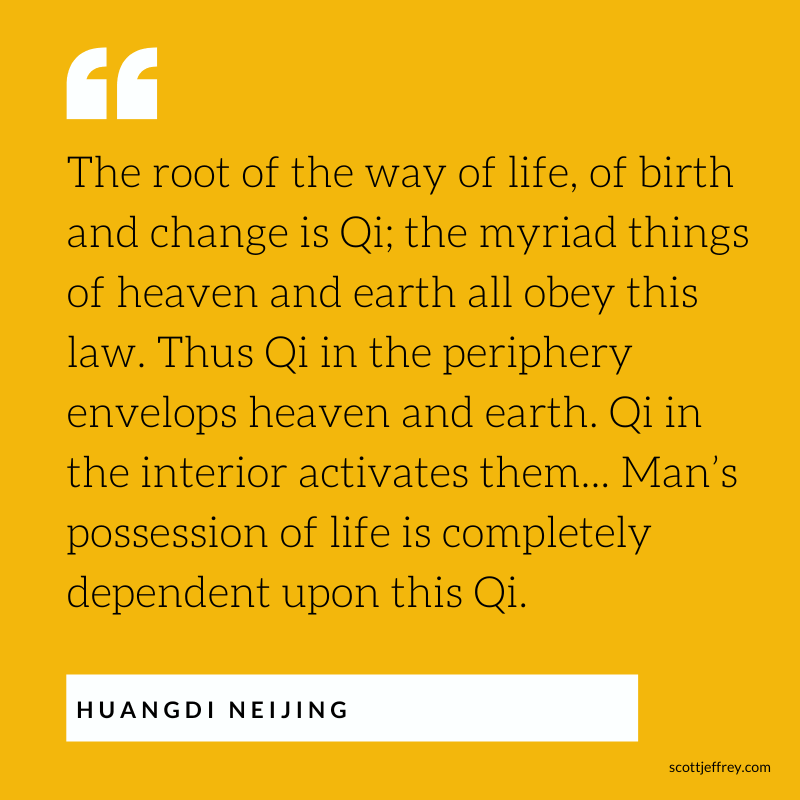
6 Practices for Cultivating Chi Energy
The original alchemists were Taoist practitioners. These internal alchemists sought methods of cultivating this primal life-force energy within their bodies. They developed numerous pathways for cultivating Chi energy.
The first step is to open one’s energetic channels via a combination of stretching, movements, postures, and breathing techniques.
Methods for cultivating Chi energy include:
- Qigong and Neigong Practices
- Internal Martial Arts
- Cultivation of Virtues
- Jing Stabilization
- Seated Meditation
- Conscious Eating
Now, let’s look at each of these options.
Qigong and Neigong Practices
We already covered qigong above. One of the best ways to begin cultivating life force energy is by learning how to stand and practicing it daily.
Neigong represents a more advanced set of practices and understanding of Chi. In fact, Neigong is specifically focused on Chi cultivation. I’ll link to a few recommended books on this topic below.
Internal Martial Arts
Generally speaking, the internal martial arts include three “sister forms”:
- Tai Chi
- Bagua
- Xingyiquan
All three sister forms have interrelated principles and different mechanics on how to cultivate and move energy through the body.
Cultivation of Virtues
The Taoist classic, the Tao Te Ching translates to “The Book of the Way and Its Virtues.”
Virtues play a central role in the cultivating of Chi energy within the Taoist arts. (Recall above how self-deception and lying disrupt the flow of Chi.)
As Qigong Master Dr. Yan Xin explains:9Yan Xin, Secrets and Benefits of Internal Qigong Cultivation, 1994, 66.
In the cultivation and application of qigong, virtue always plays a technical role that is uniquely central, pivotal, and sustaining. The source of the qi of qigong contains substances and energies based on highly unified matter and spirit. Virtue determines our ability to access this source.
According to Dr. Xin, virtues represent 70% of one’s Qigong energy cultivation.
Jing Stabilization
As we saw above from the Three Treasures, Jing (Life’s Essence) converts to Chi within the body.
Sadly, many of us regularly leak and rapidly destroy our Jing via excitation, over-stimulation, and sexual activity. For men, in particular, sex/ejaculation is the primary way Jing is depleted.
Learning and applying the principles of sexual energy transmutation is important for anyone interested in cultivating their Chi for longevity and long-term health.
Seated Meditation
Another way to stabilize Jing and cultivate Chi energy is through various forms of seated meditation.
However, meditative practices for energy cultivation are not the same as mindfulness-based meditations or other consciousness-based approaches (like Vipassana).
Cultivating energy via meditation is the focus of Nei Gong methods that are used after one establishes a foundation in proper sitting, standing, and movement-based practices. That is, the body must be open before sitting practices can be used to consolidate and circulate one’s Chi.
Conscious Eating
Besides the primordial energy that we’re born with (also called Yang Qi), the primary way we build energy in our bodies is by converting the energy from food.
Ideally, the food we eat converts into Chi energy. In my experience, learning the principles of energy and how Chi works in the body can radically change one’s orientation toward food and how one eats.
Most people associate eating with pleasure. In effect, most of us eat to “get high” and change our emotional state. For example, eating wheat produces effects akin to morphine.10Heubner, F., Lieberman, K., Rubino, R. & Wall, J., 1984, Demonstration of high opioid-like activity in isolated peptides from wheat gluten hydrolysates, Peptides 5:1139-47.
That is, we use food as a way of self-medicating ourselves without being fully conscious of our behavior.
However, when you understand the principles of energy and you develop sensitivity or body awareness, you start to eat very differently.
From the perspective of the Taoist arts, we are meant to eat mainly for energy conversion (not pleasure). When we eat for energy, we naturally eat less and we become highly selective of what we eat.
Chi Energy is the Source of Life
Chi is the source of all life.
When our Chi flows smoothly, life becomes effortless and free.
When our Chi is blocked, it leads to disharmony, tension, and discontent.
Is it worthwhile to make life changes to cultivate your Chi?
I’ll leave that for you to decide …
Related Books on Cultivating Chi Energy

Daoist Nei Gong: The Philosophical Art of Change
by Damo Mitchell
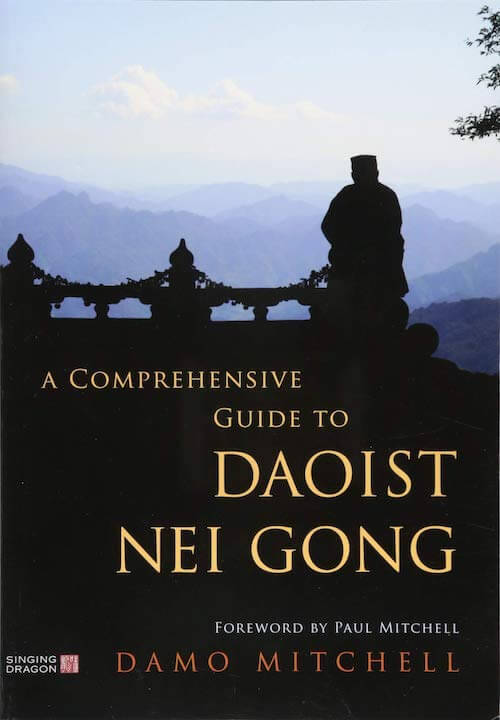
A Comprehensive Guide to Daoist Nei Gong
by Damo Mitchell
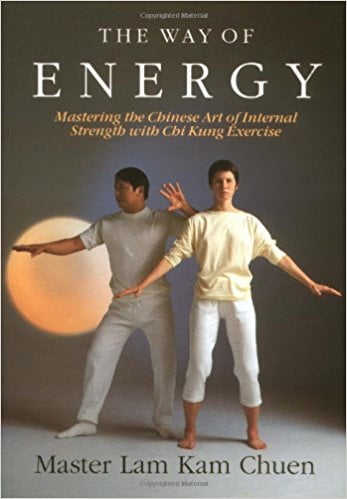
The Way of Energy
by Lam Kam Chuen
Reads Next
Do Grounding Mats Really Work? A Complete Review
How to Unleash a Storehouse of Energy by Eating Less
Best Earthing Shoes Review: Do Grounding Shoes Really Work?
7 Psychic Vampire Symptoms and How Vampires Perform Psychic Attacks

Thank you very much for such valuable information. Greetings from Spain.
You’re most welcome, Rafa!
Dynamo Jack! I wish we could know what his meditation routine is.
Excellent, I lived in China for 10 years, Taiwan for 7 years, and the Mainland for 3 years.
Thanks, Richard. Sounds like you’re spent a great deal of time in the East.
Thanks for making these articles! This is correlating to my current journey/practice of being more body aware and to what Eckhart Tolle talks about in his book “Power of Now” to be more rooted in the body and how that brings many positives for mind and body. Still an on going practice and this article, including your various others like centeredness, helps shed further light and interest. Thanks again Scott!
Sure thing, John. Thank you for your comments.
Many thanks for daring to explore these uncharted areas of spiritual depth.